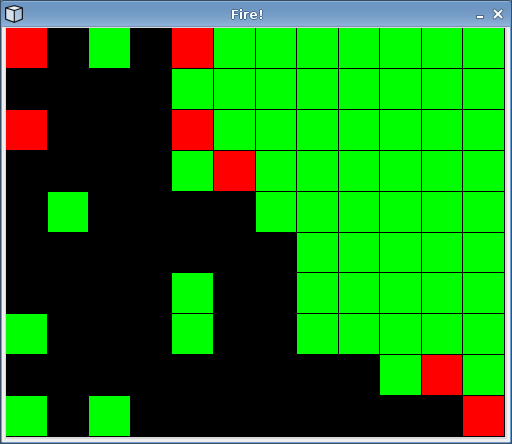CS21 HW10: A fire simulator
Some of the problems will have optional components that allow you to further practice your skills in Python. Optional portions will not be graded, but may be interesting for those wanting some extra challenges.
This assignment asks you to use object oriented design to simulate the spread of a forest fire. Your simulation will use the terrain class which we wrote for this assignment. The terrain class models a forest as a rectangular grid of r rows and c columns. Each cell in the grid is in one of three possible states:
- Forest (not-burning)
- Burning Forest
- Empty (previously burnt or cleared)
Examine the methods in the terrain class by opening an IDLE shell, importing the terrain module using import terrain and running help(terrain). The sample code below shows how the methods might be used.
from terrain import * t = terrain(10, 12) t.setEmpty(3,3) t.setBurning(1,2) t.update() t.close()The resulting terrain is shown below. Note that cell in location (0,0) in in the lower left corner.


The basic rules for updating the status each cell is as follows.
- If the cell is currently Empty, it will stay Empty
- If the cell is currently Burning, it will be set to Empty in the next time step
- If the cell is currently a Forest, and none of the cells neighbors are burning, the cell will stay as a Forest
- If a cell is currently a Forest, and one or more neighboring cells are burning, then the cell will be set to Burning in the next time step with probability p
The image below shows the status of a fire after 10 steps

- Use an instance variable to store a terrain object that will show the status of the current fire.
- Your constructor should accept the number of rows and columns for the terrain as well as a probability (between 0 and 1) of a fire spreading to a neighbor.
- Add a method that can start a fire in one or more locations. You can pick a cell to start the fire at random or use parameters specified by the user.
- Simulate one step of the spreading fire by updating the status of every cell based on the rules above.
- Simulate a sequence of steps of a spreading fire until no more cells are burning.
- Report the percentage of cells burned or burning at any given time.
- Report the total number of steps for a fire to burn out.
def main():
f = fireSim(10, 12, .55)
f.startFire(5,6)
f.spread()
print "This fire burned %0.2f%% of the terrain in %d steps" \
% (f.percentBurned(), f.numSteps())
f.close()
A sample run of this function would print: This fire burned 69.17% of the terrain in 18 steps. You may have different method names with different parameters. The design is up to you as long as you implement all the requirements.
- Use the sleep function from the time module (from time import sleep) to pause between steps of the simulation so you can watch the spread of the fire. Otherwise, you might just see the end of the simulation.
- To make an event happen with probability prob use the
random() function from the random module. The following code will
print the word "burn" with probability prob, where
prob is between 0.00 and 1.00.
if random() < prob: print "burn"
- Note that the methods setBurning and setEmpty will only update the status of the terrain on the next call to update. Thus, you can set the status of cells in the next step using setBurning and setEmpty and make one call to update after all the cells in one step have been set. If your terrain seems to update too fast or not at all, it may be a problem related to not using the update method of the terrain class properly.
- The isBurning and isEmpty methods in the terrain class return False and True respectively if the row or col parameters are outside the terrain boundaries. This can make checking if a neighbor is on fire a bit easier for cells that are on the edge of the terrain.
- Add a method close to your simulator that will pause when the simulation is finished instead of immediately closing the terrain window.
There are many extensions you could add to this program. You could modify how the fire spreads by adding additional rules or parameters. For example, perhaps the probability of catching on fire depends on the number of neighboring trees that are on fire. Perhaps you can add a wind direction and modify the probabilities such that trees down-wind of an active fire are more likely to burn. Perhaps you can create an initial grid with a few "fire lines" of empty cells to prevent fires from spreading. Add a feature where cells could randomly start burning even if no neighbors are burning (as happens with lightning). Allow fire to spread to cells that are more than one cell away. If you allow this feature, can you get a fire to jump a fire line? More complex models could factor in topography, soil moisture, smoldering fires, etc., and are actually used in some geographical information system (GIS) applications for predicting and modeling forest fire risk.
Once you are satisfied with your program, hand it in by typing handin21 in a terminal window.